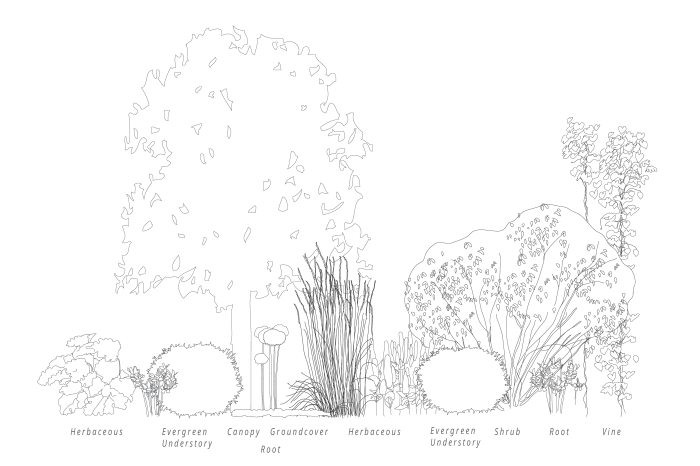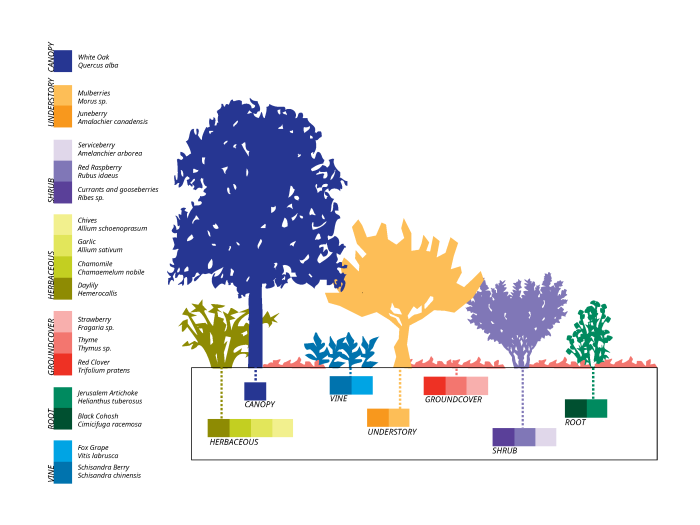Layer and Function Diagrammed
A popularized form of permaculture is Forest Gardening, which takes the principles of a nutrient-cycling forest and brings them to the garden. The idea is to mimic the cycle of deciduous leaves creating a nutrient-rich mulch that covers and protects the soil, supporting a variety of herbaceous plants and their associated beneficial insects under a canopy of shrubs, sub-canopy trees and large trees. This concept is illustrated by dividing plants into groups based on the layer they occupy in this mimicked forest system. There are typically seven layers:
Let’s go through the seven different layers, to explain the terminology and function of each, with a few example plants that herbalists use:
1- Rhizosphere (Root Zone)
Soils are a mysterious and wonderful aspect of the system; literally mineral and animal and vegetable all in one. The parent rock interacts with the plants growing on the soil, which also add and build the soil, and organisms interact with the roots and the nutrients to both break down and build up the soil. This is where the ROOT ZONE resides; and the roots determine how the plant does above soil.
Roots push into the soil, loosening it and making it more friable. When root hairs die, or when roots are harvested, resulting air pockets make room for the next round of roots, and that lucky following plant doesn’t have to work so hard. The root plant also leaves behind valuable symbiotic fungi to speed nutrient transfer to the following plant.
Example Plants:
- Cohoshes, Blue and Black
- Burdock, Yellow Dock, Dandelion
- Garlic/Onion (as annuals)
- Gravelroot
- Solomon’s Seal
2- Groundcover (Understory)
The groundcover layer acts as a living mulch, covering the soil and protecting it. The groundcover layer is often walk-on-able (think of grass), but can be edible (think of sweet woodruff). Groundcover roots form an important erosion-controlling mat, and the low, tight-to-the-ground leaf cover protects soil from raindrop ‘plash’, which can scatter bare soil and cause erosion.
Example Plants:
- Evergreen choices: Thymes, Bearberry, Spotted Wintergreen/Pipsissewa
- Almost evergreen: Wild Ginger, Bugleweed
- Deciduous choices: Wild Geranium, Arnica, Yarrow, Fringed Bleeding heart, Lily of the Valley
- ‘Weeds’ herbalists allow: Chickweed, Plantain, Ground Ivy, Dead Nettle, Violet
3- Herbaceous layer (Understory)
The herbaceous layer is full of the low-growing, flowering plants that herbalists use for making aromatic teas. This layer adds organic matter and builds the humus layer of the soil, while conserving and cycling large quantities of critical nutrients in situ. Herbaceous plants contribute greatly to plant diversity to support beneficial insect diversity through a rich nectary library. They are closer to the soil, which gives off large amounts of carbon dioxide and helps it to be more productive food-wise.
There are lots and lots of examples of this layer used by herbalists:
- Ferns (Royal fern is used herbally, Ostrich fern is edible in fiddlehead stage)
- Aromatic culinary herbs: Chives, Dill, Sorrel, Lovage, Peppermint, Spearmint, Lemonbalm, Chamomile, Thyme, Marjoram, Wood Betony
- ‘Weeds’ herbalists allow: Borage, Comfrey, Nettle, Celandine Poppy, Mullein
- Peony (Traditional Chinese Medicine)
Taller grasses work here too, adding biomass that can be cut in the spring and laid down for instant mulch with no extra cost or shipping. All winter, it served as someone’s home.
4- Shrubs (Middle)
The shrub layer is important for bird cover. Birds come, rest, feed, and defecate, bringing biodiversity in the form of ‘shat plants’. Shrubs also provide food (think of all the berries!!), bark and roots for herbalists, as well as sticks, kindling, and more biomass.
Example Plants:
- Meadowsweet
- Blackberry
- Raspberry
- Elderberry
- Blueberry
- Crampbark (Viburnum opulus)
5- Small Trees (Overstory)
The small tree and shrub layers tolerate some shade, and are an intermediate layer between the trees and the shrubs. Both the small tree and shrub layers add vertical diversity and habitat, and increase the forest’s productivity. Think of fruiting trees like Juneberry.
Example Plants:
- Juneberry
- Dogwood
- Sea Buckthorn
- Witch Hazel
6- Trees (Overstory/Canopy)
The canopy layer takes up most space, gets the most sun, and uses the most nutrients and water. Canopy trees dominate photosynthesis and biomass creation: deciduous trees add organic matter each fall. Trees influence soil environment by the character of its nutritional needs and leaf litter quality (for example: oak leaves don’t break down as quickly as maple leaves do; walnuts put out juglone that only certain species can grow with).
The pattern of the canopy affects how rain hits the soil and the amount of sunlight that enters. Some good examples of useful shade-tolerant trees are American beech and sugar maple. An example of a troublesome tree is the Norway maple – a heavily leafy tree producing tons of shade very early in the spring, with a fibrous root system at the surface that dries up the soil. Norway Maples have a spreading problem – each tree makes tons of samaras that readily seed.
Other trees like Oaks, with deep roots, bring up minerals from deep in the soil. Capillary action brings moisture up where other plants can get at it within the soil column. When trees die and rot, it provides a home for various fungi, and sets up certain types of relationships with other woody roots in the vicinity.
Example Plants:
- Hawthorne
- Peach
- Walnut
- Redcedar (Juniperus virginiana)
- Thuja
- Elm
- Ginkgo
- Linden
- White Oak
7- Vines (middle, knit all layers together)
Vines can develop in any of the other layers, and work to weave or knit the layers together. Vines can become parasitic and annoying, especially opportunistic exotics. If we host them, we must manage them with appropriate structural support, pruning, an generally keeping them in check. Vines are adaptable to our needs: grapes are most common, hardy kiwis are great in shade.
Example Plants:
- Hops
- Grapes
- Hardy Kiwi
- Schizandra
- Codonopsis
- Passion Flower (annual)
- Peas and Beans (annual)
- Morning glories (annual)
I pulled together a diagram showing the layers with example plants used by herbalists:
The take-home message from the seven layer concept is that the more layers, the more bird, microbe, beneficial insect, species supported; and biodiversity means a richer, more robust and resilient environment. More layers also means more opportunities for food or ‘yield’ in a small space.


